When I started running regularly after graduating from college, the marathon sounded impossibly far. I’ll never do that, I thought. I’d heard horror stories of lost toenails and cripplingly sore quads…
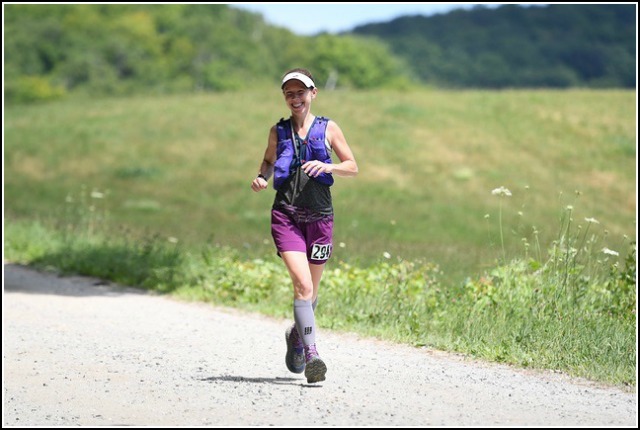
It’s funny how your mindset shifts! Fast-forward 20 years, and I found myself about to run a 100 mile ultra marathon.
July 21st loomed large in my mind since I registered for the Vermont 100 miler the previous January. As the race date approached, I kept waiting for the panic to start.
100 miles. 17,000 feet of climbing and descent.
Could I really do this?
The weeks passed quickly and suddenly I found myself packing to travel to Vermont for my first 100 mile ultra.
But oddly enough, the panic that I anticipated never came. Not when my alarm went off at 2 am on race morning and not when I finally stepped up to the starting line under a star-filled sky.
I felt remarkably calm. Don’t get me wrong – I was excited and there were certainly some butterflies in my stomach. But never any panic.
In the end, this race couldn’t have gone much better than it did:
- I finished my first 100-miler well within my goal of under 24 hours: 23:39 to be exact.
- I’m probably most proud of the final 30 miles I completed in just over 7 hours.
- I passed over 30 women in those miles to move up to 22nd female overall.
When you’re running that far, luck always plays a role in your success. I had great weather. The course was dry and my feet held up amazingly well.
But looking back after the race, I also realized that my consistent preparation is what kept my panic at bay and allowed me to execute my race plan successfully. I controlled everything that I could and prepared for whatever I couldn’t.
While the preparation for running 100 miles is particularly intense, the lessons I learned are applicable to a variety of races, whether they’re on road or trail.
Race day is the culmination of your training and planning.
Executing both of those well can be the difference between pride and disappointment, and in a 100-miler can mean the difference between finishing the distance and leaving with a DNF (Did Not Finish).
How I Chose My First 100 Mile Ultra Marathon
Success begins with selecting an appropriate challenge. In hindsight, Jason probably shouldn’t have chosen a mountainous first ultra at altitude that resulted in a DNF…
I thought about running the Vermont 100 mile ultra marathon for nearly 2 years before I finally registered and knew it was a course that would both challenge me and play to my strengths.
I was slightly terrified by the thought of 17,000 feet of climbing, but knew that having about 65% of the course on dirt roads would allow me to keep moving well without the worry of more technical terrain.
The Vermont 100 is a well-established race and one of the oldest 100-milers in the country. They also have an abundance of both manned and unmanned aid stations along the course, so you’re never more than 5 miles from hydration and fueling options.
Knowing the race was well organized with such a huge amount of on-course support was also appealing as a first 100 miler.
Consistent Training Was Clutch
What stands out most to me about my build up to Vermont was the consistency. Jason always says that consistency is the “secret sauce” to successful running, and this has proven true for me in all my training and racing!
What might be most notable is the fact that I didn’t run crazy high mileage while training for this race, but I did run months of 50-60 mile weeks, with two weeks peaking at just over 70 miles.
I raced a 50-miler about 2 months before the 100 mile ultra to allow for plenty of recovery time and my last long run was a hot and hilly 35-miler.
While living outside of Philadelphia didn’t give me an opportunity to do any massive climbing during my runs, hills were an essential part of my training. More than the mileage itself, the thought of 17,00 feet of climbing scared me. I tried to do as much as I could to prepare my body for all that elevation gain and descent.
Although I had run a 100k in the fall of 2017, I had never run in the overnight hours during any previous races. To help prepare myself mentally, I did two late night long runs during training, one on trails and one on a paved path.
The heat was also a potential difficulty with a mid-summer race so in the final 4-6 weeks before race day I exposed myself to as much challenging weather as possible.
I ran at 3 pm on 95-degree days and practiced fueling and cooling strategies. While I hoped for better weather, I felt acclimated and ready to deal with steamy conditions if necessary.
Fuel Right to Run Strong
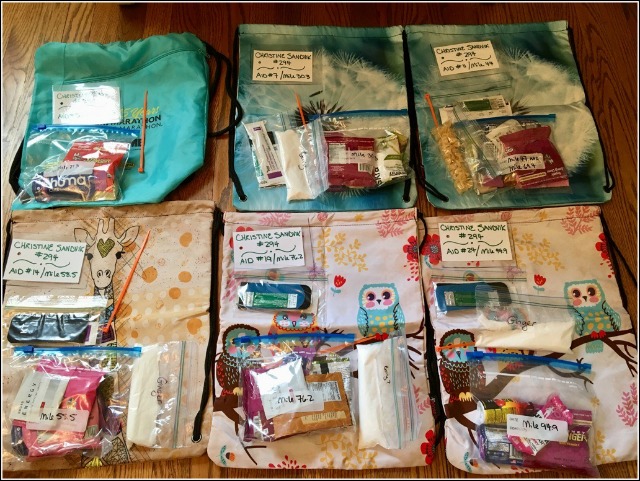
The longer the race, the more nutrition becomes a factor. My stomach always has the potential to get a little wonky in long races (especially in the heat).
My race plan was to eat about 150-200 calories per hour, knowing I would probably fall short of that as the race progressed.
Long training runs were essential to nailing down my nutrition. I played around with different fueling sources ranging from gels (Huma and GU) and chews (Honey Stinger and Skratch), to liquid calories (Sword), to real food like fruit and cereal bars (and Snickers bars too!).
Different options were going to be needed as the race progressed and if I tired of my usual choices, the aid station fare would be helpful too.
I calculated the calories I would need between planned aid stations stops and then filled labeled Ziploc bags with the appropriate amount of fuel. Each bag had a variety of options, including at least one of each of the above sources.
I based this on a 14-minute mile, calculated how long I would take, and then approximately 200 calories per hour.
For example:
- From the aid station “Margaritaville” to the aid station “Camp 10 Bear” was roughly 11 miles.
- At a 14 minute per mile pace (planning for a pace that would keep me under 24 hours), this would take 154 minutes or roughly 2.5 hours.
- This bag would have about 500 calories worth of food in it (2.5 hours x 200 calories/hour)
Here’s more specifics on how to eat and fuel appropriately for running.
Gear, Bags, Crew, and More Ultra Marathon Logistics
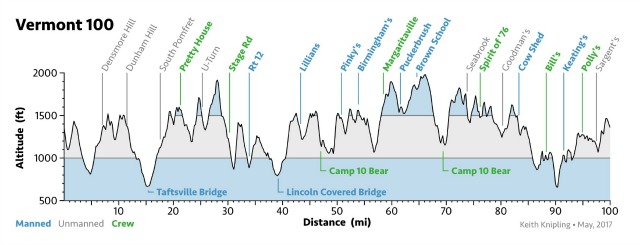
During the race, my crew planned to meet me at 7 of the 8 aid stations that allowed them there. The race provided very detailed driving directions, which I printed and laminated. They drove out to most of the aid stations the day before the race to get a sense of how long it would take to get to each one, especially since there is minimal cell service in the area.
I provided my crew and pacer with a chart that calculated times I would arrive at each aid station, as well as times that would account for me running either faster or slower than my goal pace. Given the preparation and planning, it was unlikely that they would miss me at any of the aid stations.
But because I tend to act like Girl Scout and plan for every scenario, I also had planned drop bags to leave at each of those aid stations in case I missed my crew.
Every drop bag contained the following:
- A second set of food bags with all my pre-calculated calories.
- Mini foot care kits with KT tape, alcohol pads, benzoin swabs, and blister supplies.
The drop bags at the later aid stations also had a variety of supplies for potential overnight needs:
- My primary headlamp was in my drop bag at mile 58, while my waist light was with my crew. I wanted to run with both overnight but would be ok just the headlamp in case I missed them.
- At mile 69.4 I planned to change into a new long sleeve shirt and hat and had access to rain gear for overnight just in case.
- I left a backup headlamp and extra batteries at mile 76 since I was a little paranoid about running overnight in the dark!
- At mile 88 I had an extra shirt in case I got cold (in addition to the extra clothing with my crew), gloves, and a change of socks.
To make it easier for my crew, I gave them two lists. One was a checklist of things to do or ask me at every aid station. These were tasks that might have been easy to forget like:
- sunscreen
- bug spray
- lube
- taking any trash I had
- getting my appropriate bag of food
The second list was specific to certain aid stations, such as when I wanted my waist light and rain jacket.
I also had a bin of backup supplies that I hoped I wouldn’t need. This would stay in the car unless I needed my crew to retrieve something specific.
The supplies in here ranged from extra clothes and shoes to batteries and food, and even an extra hydration pack in case something went wrong with mine.
Fortunately, I never missed my crew and only needed a change of shoes once during the race.
There Will Always Be Surprises
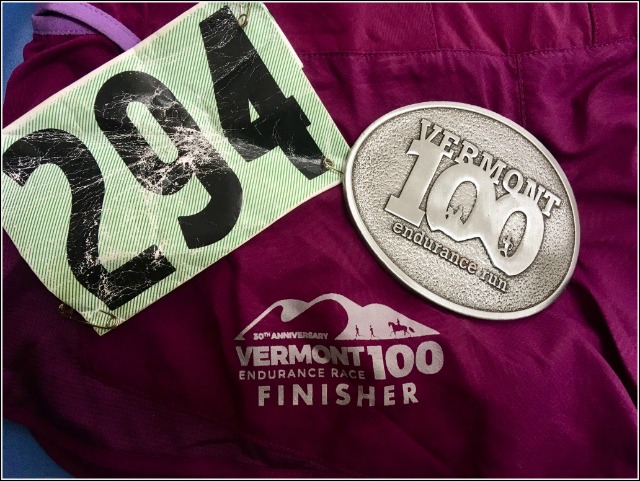
My thorough preparation didn’t stop me from almost making a major mistake right before the race started.
After finally falling asleep the night before the race, I woke up at midnight and my brain was racing. I realized I packed all my headlamps and almost forgot to take out the one I would need at the start at 4am. This would have caused some serious challenges in the pre-dawn hours!
I retrieved the headlamp when I got up and got dressed, but didn’t turn it on until we were walking out the door. That was fortunate timing, since for some reason the batteries that I thought were new didn’t work.
I raced back in the house and got a new set – thankfully I knew exactly where they were. Crisis averted. Twice.
100 Mile Ultra Marathons Require Adaptation
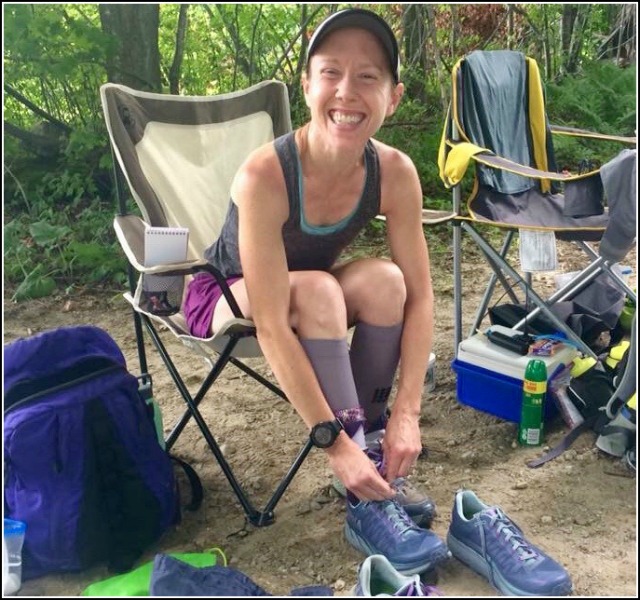
Once I crossed the start line, however, my focus shifted from preparation and organization to focus and adaptation for the next 23+ hours.
Fueling and hydration were a huge priority that I couldn’t neglect. I also had to manage any minor issues early so that they didn’t become overwhelming problems as the race progressed.
While I didn’t want to watch my pace too closely, I did check it intermittently in the first 30 miles to make sure I didn’t start too fast. I had originally planned to turn off the “beep” on my Garmin at every mile, but it ended up being a good reminder to fuel and hydrate at regular intervals.
Early on, one of my planned fuel sources (the Honey Stinger chews) didn’t settle well. So for the rest of the race, I made sure to pull out alternate fueling options from my crew and drop bags so I could avoid them.
When my quads and IT bands began to hurt at mile 40-something, I had a fleeting moment of panic. What if they became too painful to run during the later miles?
But I put that worry aside and stay in the moment. I had a change of shoes, ibuprofen if I got desperate, and even a couple of IT band straps with my crew if I needed them. While the ache was fairly constant (especially on steep downhills), the pain never became unbearable and I was able to keep moving steadily.
Planning and consistent training undoubtedly laid the foundation for a successful race.
But I also attribute my positive experience to some less tangible strategies:
Choose your support crew wisely
Not only did I have an amazing crew and pacers, but I was also fortunate to share the first 65 miles of the race with my friend and training partner. The company made the miles fly by and we were able to support each other with ongoing feedback and encouragement.
My crew was prepared and attentive and ready to address my needs at every aid station. I was lucky enough to have my wife crew me, and she also shared the last 5 miles and an emotional finish with me.
My pacer from miles 70-95 was experienced and knew exactly when to push and when to encourage, especially when it came to reaching my sub-24 goal. He knew the mileage between aid stations and reminded me to eat when too much time had passed between refueling.
A pacer doesn’t necessarily have to be experienced, but making your needs and expectations clear before race day will make for a more positive experience!
Stay in the moment
This concept can be overused but nowhere is it more useful than in a 100 mile ultra marathon.
Thinking about what already happened or what’s ahead can easily overwhelm you in a long race. Keep an open mind, run the mile you’re in, and try to adapt in the moment as needed.
Be a problem solver
When something does go wrong, don’t waste emotional energy worrying about it. Try to use your brain without getting caught up in your emotions.
Take action. Think: “What can I do to address this in the moment?”
Addressing small problems as they arise will likely save you time and frustration later.
Be grateful
Even in your lowest moment, remember to be grateful for the opportunity to be out on the course.
It’s easy to lose sight of that when you’ve been on your feet for hours, but find something to appreciate, no matter how small. Vermont’s natural beauty and the good weather made it easy for me to appreciate the course and I was endlessly grateful for those helping me to achieve my goal.
My first 100-miler was an adventure I’ll never forget, and reaching my sub-24 goal was a culmination of my training, preparation, and planning coming together in the best way possible.
I’m looking forward to the next one!
Related Resources:
- How to Run Your First Ultra
- Strength Running Coaching Programs
- Discover Your Ultramarathon by Doug Hay
- Pro Magda Boulet on how to run your first 100 miler (podcast)
- Hal Koerner’s Field Guide to Ultrarunning